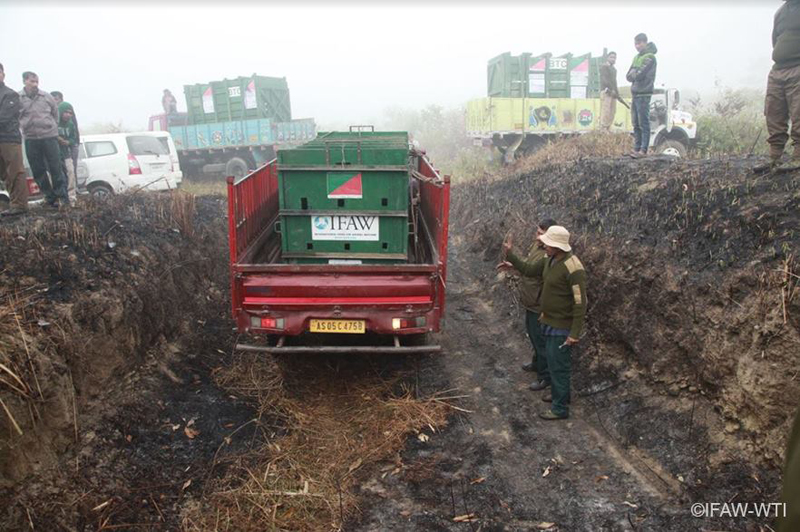Road Trip For Rescued Rhinos May Give The Species A Lift
In India, conservationists truck orphaned rhinos from a rhino-rich park to one with a rhino deficit.
By Vicki Croke

Each of the three greater one-horned rhinos arrived at Manas National Park unscathed, if a bit smudged from the travel crates. Photo: Subhamoy Bhattacharjee/IFAW-WTI.
Three young female greater one-horned rhinos who were saved as orphans from monsoon floodwaters in 2016 and hand-reared at one national park, have just been moved to a different park in the foothills of the eastern Himalayas. It’s part of a conservation effort in which rescued and rehabilitated rhinos from a park with the largest concentration of this species can now be moved to help repopulate another park with suitable rhino habitat in India.
It was just last week that the animals made the 230-mile trek from Kaziranga National Park to Manas National Park, according to the Wildlife Trust of India and the International Fund for Animal Welfare—two groups working with the Assam Forest Department on the project. The convoy of trucks and other wildlife vehicles carrying conservationists, veterinarians, officials, and, of course, the crated rhinos, drove overnight through dense winter fog and darkness. They arrived at Manas just before dawn on Saturday.

Three crates for three rhinos: the orphans brought the total rhino population for Manas National Park up to 35, according to the Wildlife Trust of India. Photo: IFAW-WTI.
Inside huge green-painted wildlife crates, were the 1 ½-year-old greater one-horned rhinoceroses—Haldibari, Deopani, and Sildubi, each named after the region they came from. The animals, whose thick, segmented skin looks like armor plating, were unscathed, according to the vets traveling with them. “The calves are none the worse for wear following their long journey,” attending veterinarian Dr. Bhaskar Choudhury said in a statement from the Wildlife Trust of India. Though there were smudges of green—on shoulders, ears, horn, ribs, and rump—where the animals had rubbed against their crates during transport.

Plenty of patience: It may take more than two years for the rehabilitated rhinos to be ready to live completely as wild rhinos. Photo: Arunav Baruah/IFAW-WTI.
The immediate plan, according to IFAW, which in cooperation with the Wildlife Trust of India and the Forest Department, runs a mobile veterinary unit as well as the Centre for Wildlife Rehabilitation and Conservation in Kaziranga, is to get the rhinos accustomed to their new habitat and then, following long-established rescue protocols, to guide the maturing rhinos to complete independence in the wild over the next couple of years. The animals will continue to be monitored even as they live as wild rhinos.
The larger conservation strategy is to continue to transfer rhinos who are good candidates, from Kaziranga to Manas. Transfers like this have been ongoing for several years. The benefit, biologists say, is that it can provide more space to a recovering species and their offspring, and, separate populations are then less vulnerable to the spread of disease.
A quick video overview of how the orphaned rhinos were first rescued in Kaziranga National Park. Video: IFAW-WTI.
Manas National Park is a UNESCO World Heritage site, but one that deteriorated during civil unrest through the late 1980s and 1990s. IFAW and WTI have been working with government agencies to help bring rhinos back to Manas since 2003. The transfer of the three female rhinos last week is “a key step in the repopulation of Manas National Park,” according to Katie Moore, of IFAW.
Kaziranga is home to more than 2,400 rhinos—that’s about 70 percent of the global population of greater one-horned rhinos. And now Manas has 35—that’s counting the newly-added females.

The segmented skin of the greater one-horned rhino looks like armor plating. Photo: Arunav Baruah/IFAW-WTI.
Greater one-horned rhinos are also protected in neighboring Nepal—in Chitwan and Bardia national parks, where similar transfers have taken place.
IFAW and WTI have previously moved ten other rescued and rehabilitated rhinos from Kaziranga to Manas. Those transferred rhinos have proved resilient and reproductively robust. IFAW reports that six calves have been born in the wild to those rehabilitated and translocated rhinos.

The transfer of the female rhinos is “a key step toward repopulating Manas National Park,” according to one of the groups spearheading the program. Photo: IFAW-WTI.
Increased protections have reduced poaching in India, though with wildlife traffickers seeking rhino horn, that effort is ongoing. One female rhino was killed by a poacher in Kaziranga just this week. “Strict enforcement has reduced poaching incidents,” a spokesperson for WTI said by email, “but they have not completely stopped.” The story of recovery for the greater one-horned rhino, a species often also called the Indian rhino, is a hopeful one. According to the World Wildlife Fund, the species came close to extinction earlier in the 20th century, with perhaps only 200 left, but today it’s estimated that there are 3,500 greater one-horned rhinos in the wild in Northeast India and Nepal.
Also on The Wild Life: Our story from 2015 about another orphaned rhino rescued from monsoon floodwaters in Kaziranga National Park: http://wbur.fm/1fuU6TP
